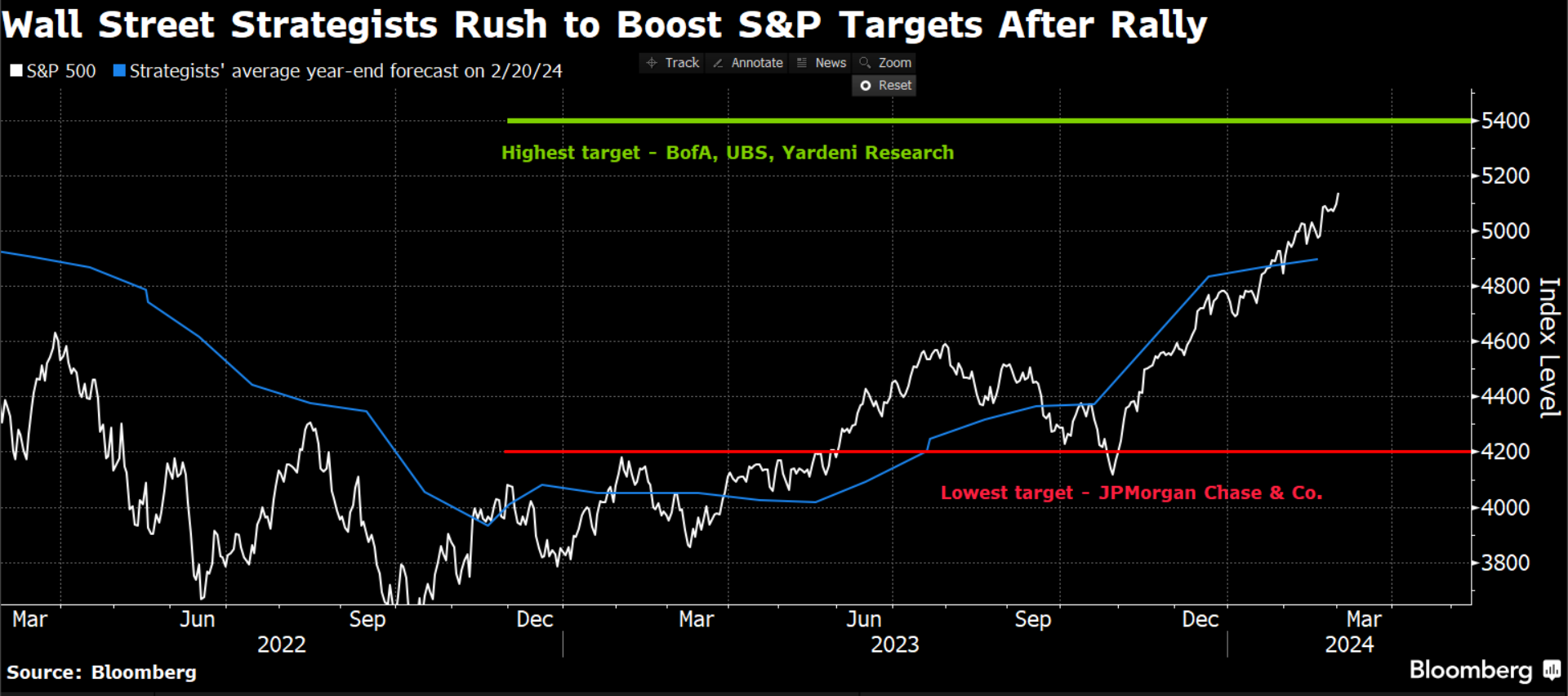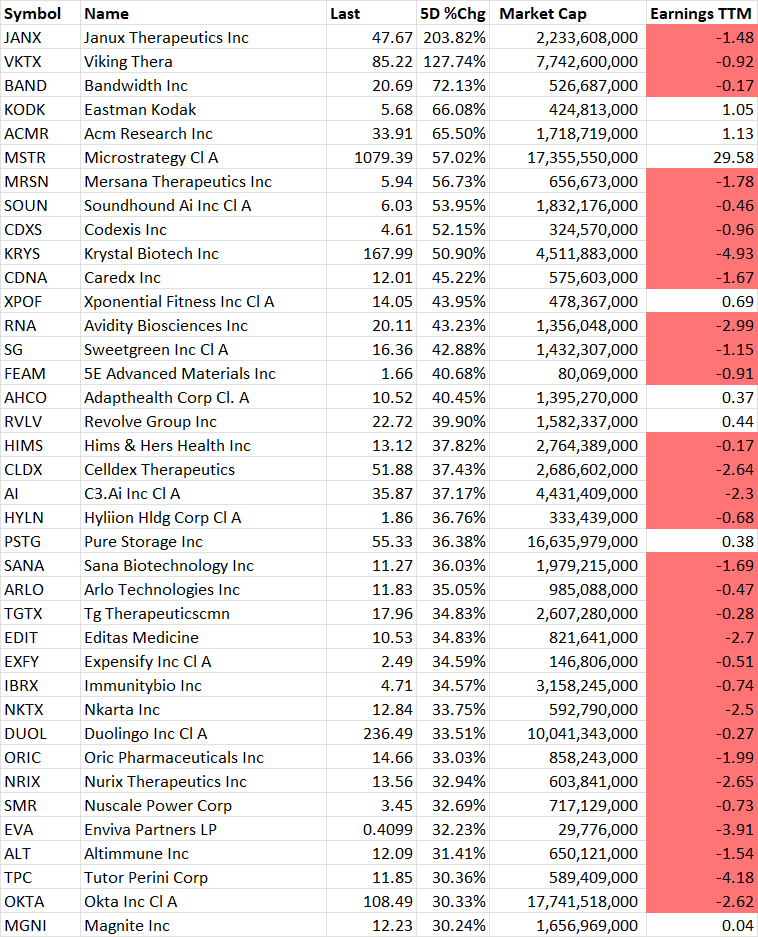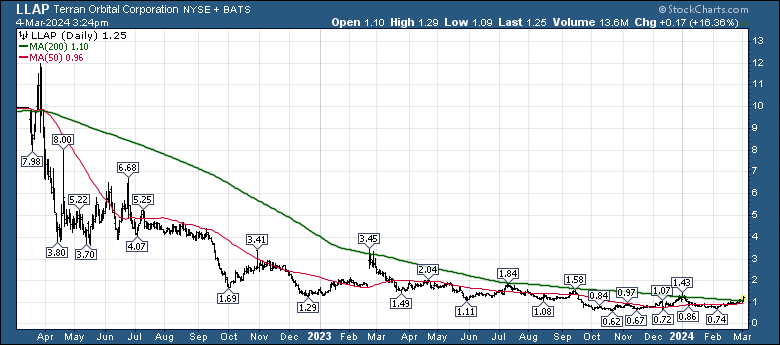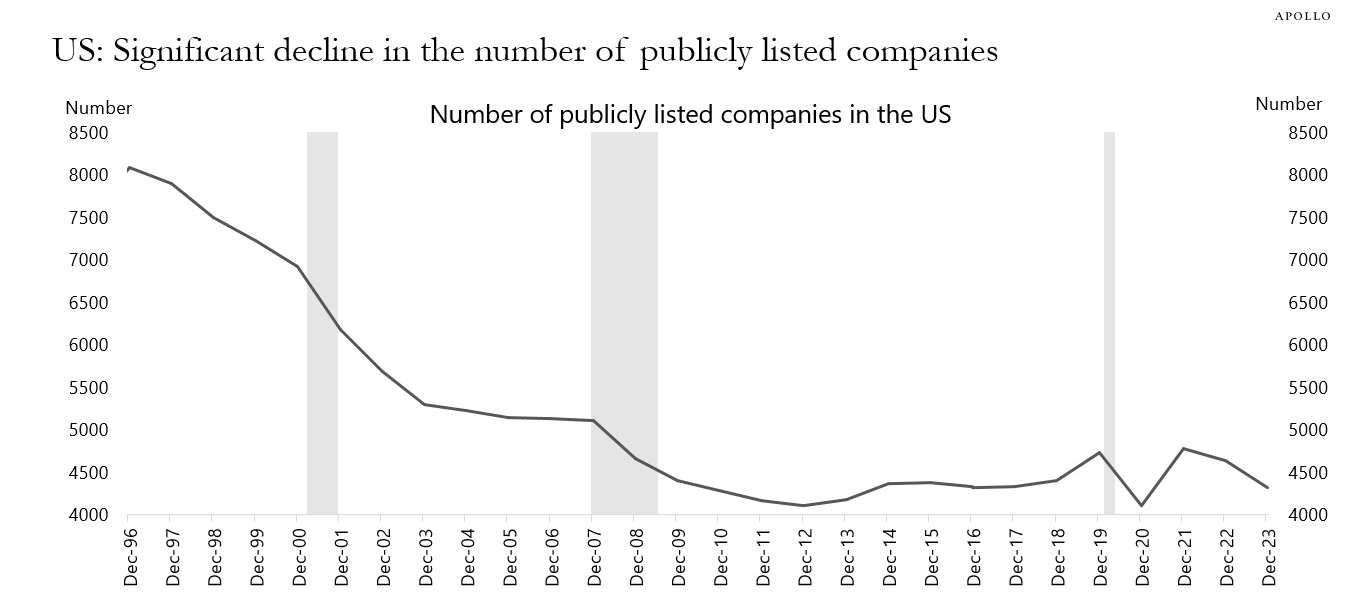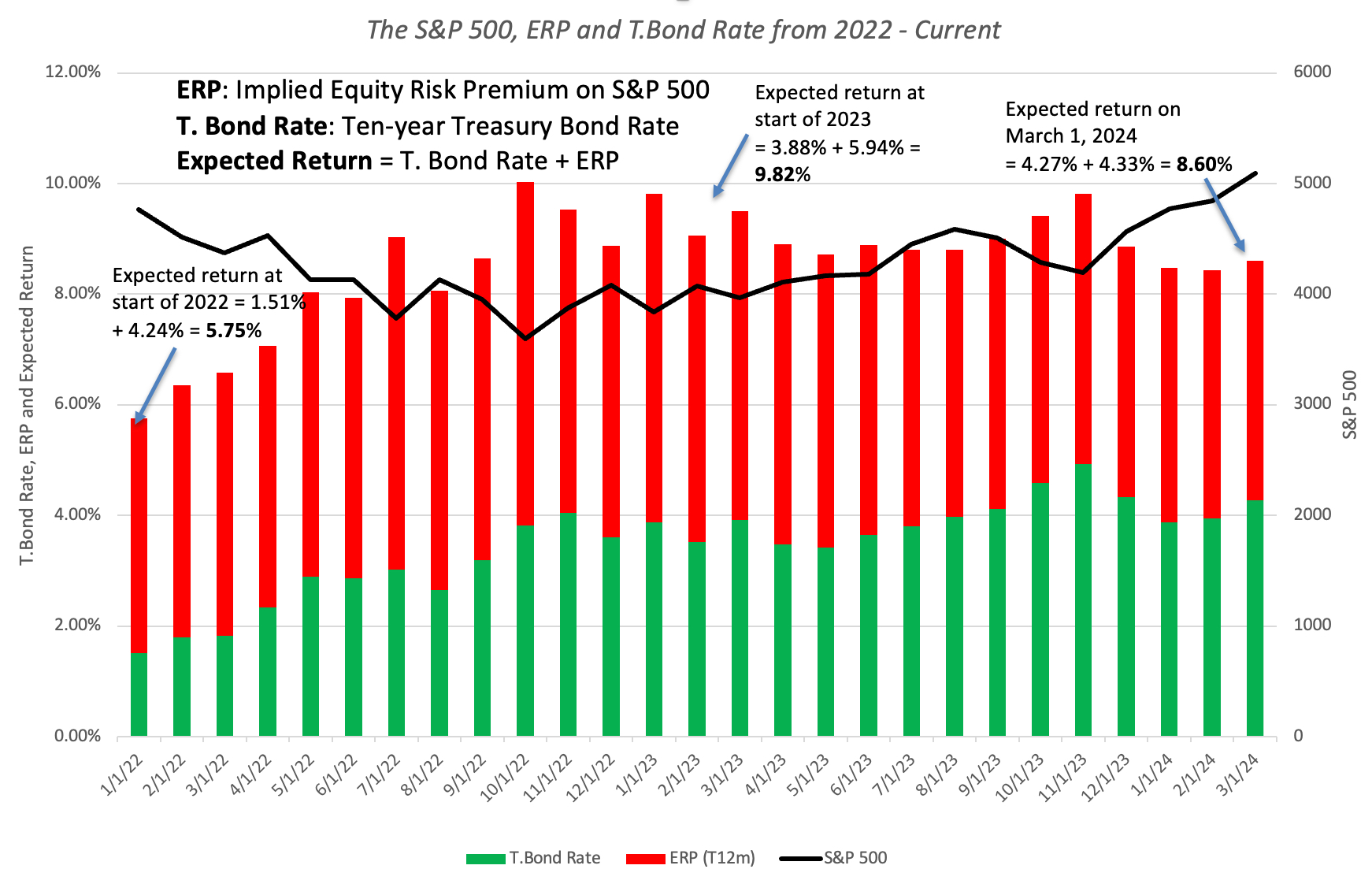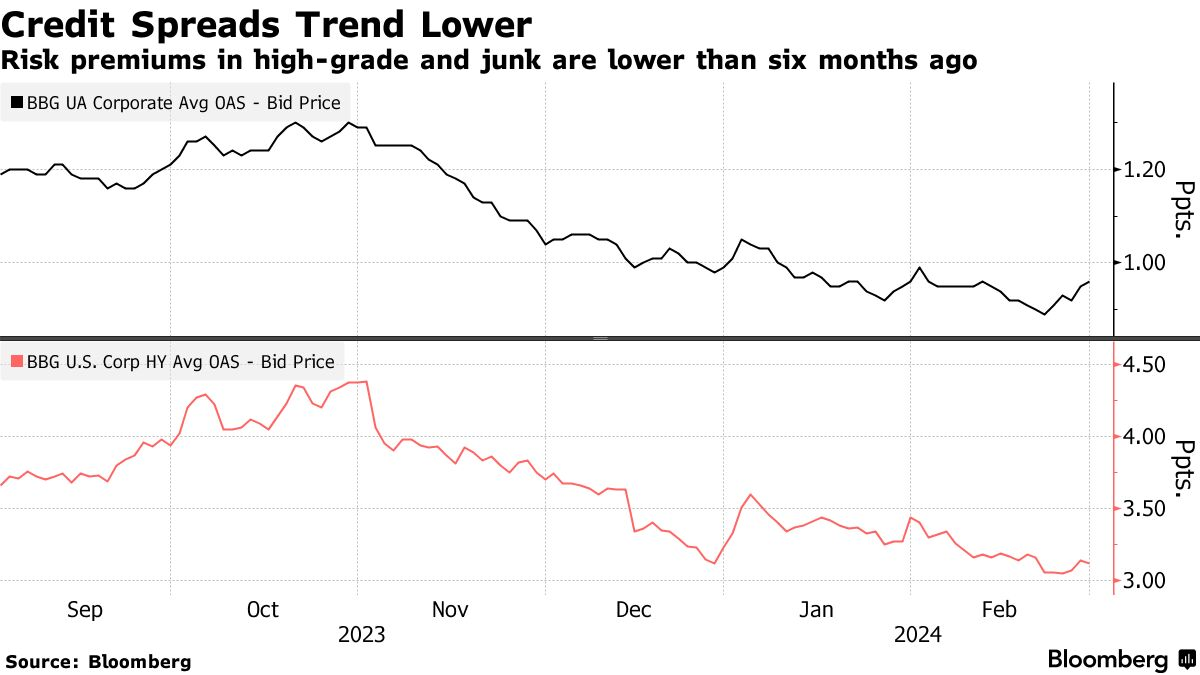
Weekly Research Briefing: Zooming Out of Frame

The markets are off and running now. Big and small. U.S. and International. Low risk, but now shifting toward higher risk. 20-day new highs are breaking out across the market. And so are the all-time highs as I count 143 new large cap ones on Monday. Everything from NVIDIA to Sprouts Farmers Market. The Small Cap indexes appear inspired by the Nikkei which finally surpassed its 1989 peak. As you will see in the details below, this is a very broad-based move now. Just notice all the money losing small caps leading the markets recently. Not a good time for those short stocks or sitting on piles of cash.
This move is all about positive economic growth, expanding margins and rising earnings. The 'E' is rising as we look forward to the 2025 and 2026 estimates and as the global economies put up better growth. Sure, the bulls would love to see Treasury rates back below 4% and maybe we will get there if the shelter cost series breaks down. But right now, the market cares less about the Fed and more about missing out on all this great growth potential. And with hungry investors opening the lid of the equity markets, companies are lining up to sell some shares to take care of their balance sheet issues or high-cost debt. The next few months will be key to seeing how all the new equity issuance is absorbed.
This week we will see how the weather affected jobs data of January normalizes. Will non-farm payrolls slide back to a 200,000 rate? Will average hourly earnings fall back as hours work rises? Stay tuned. Plenty of investor conferences and analyst meetings to give us some intra-quarter updates. Also, some Fed speak.
We are taking next week off to catch up on a couple of movies before watching all the envelopes opened on stage. Have a great couple of weeks!
And the market Oscar for longest recovery goes to the Nikkei 225...
@wallstengine: The Japan's Nikkei 225 surpasses 40,000 for the first time.
The market bulls are escaping...
@carlquintanilla: B of A: “.. We raise our S&P 500 year-end target to 5400 .. Margins have held up despite big swings in rates and inflation .. Areas of euphoria are thematic and secular: AI, GLP-1, etc. We expect the market to broaden beyond these themes ..” [Subramanian]
All the coolest market cats are raising their market price targets now...
Bank of America Corp.’s Savita Subramanian is the latest equity strategist to ratchet up her target for the S&P 500 Index to among the highest on Wall Street after this year’s rally left forecasters blindsided.
Subramanian now expects the benchmark to end the year at 5,400, compared with her earlier target of 5,000 — implying a gain of about 5% from Friday’s close. Indicators are flashing bullish signals on stronger earnings growth ahead and “surprising” profit margin resilience, she said.
“Bull markets end with euphoria — we’re not there yet,” Subramanian, the bank’s head of US equity and quantitative strategy, wrote in a note to clients on Sunday. “Sentiment has improved, but areas of euphoria are limited.”
BofA’s 5,400 price target for the S&P 500 in 2024 now ranks as one of the most bullish on Wall Street, according to about two dozen sell-side strategists tracked by Bloomberg. She joins the ranks of Ed Yardeni of Yardeni Research and Jonathan Golub of UBS Group AG, who both hold the same year-end outlook.
Strategists lifting price targets have good timing as we enter a favorable three month window for equity returns...
BofA Global
Perfectly stated...
Did you notice the U.S. retirees smiling a bit wider in January?
25% of American adults receive social security payments and in January, those checks rose by 3.2%. Now add in their home equity values and their stock portfolios and how are they not all on cloud nine?
Maybe it is because the inflation measures are still being stubborn...
Last week's January core PCE data came in a bit hot as the housing component remains shrouded in mystery. But going forward, it should remain the heaviest weight to pulling inflation lower.
Goldman Sachs
February ISM survey had some really good internals...
@conorsen: ISM: “40% of manufacturing GDP contracted in February, down from 62% in January. More importantly, the share of sector GDP registering a composite PMI® calculation at or below 45% — a good barometer of overall manufacturing weakness — was 1% in February, compared to 27% in Jan”
And weekly railroad volumes continue to rip...
Zoom in on intermodal containers. Also consider that coal volumes are 25-30% of the volumes.
@wabuffo
We like to monitor rail traffic because of its relationship with ISM Manufacturing data...
BofA Global
Cardboard volumes are another great read on manufacturing data...
In the consumer space, cruise ship demand remains full steam ahead...
These earnings surprise also launched the stock +20% higher.
Norwegian said its booked position is currently at an record high due to healthy consumer demand. Norwegian said it has enjoyed some of the best booking weeks in its history since Black Friday in November last year. It ended 2023 with an advanced ticket sales balance of $3.2 billion—56% higher than at the end of 2019.
Norwegian said it expects to post an unexpected profit in the first quarter. It sees adjusted earnings per share (EPS) of 12 cents in the first quarter, compared with expectations of a 20 cents per share loss, while full-year EPS guidance of $1.23 is narrowly ahead of estimates.
Taiwan, meet AI driven semiconductor demand...
The industrial production index in January increased 15.98 percent year-on-year, the Ministry of Economic Affairs reported yesterday, ending 19 months of consecutive declines...
Manufacturing output, which accounted for 95.41 percent of the index, rose 16.63 percent annually in January, also ending a 19-month downtrend, the report said.
Output received a lift from robust demand for artificial intelligence (AI) applications, high-performance computing (HPC) and cloud data services, as well as the effect of firms stocking up ahead of the Lunar New Year holiday, it said...
The computer and optical products industry reported the largest output increase of 35.3 percent in January, on the back of strong demand for servers, computer peripherals and handset camera lenses, ministry data showed.
The electronic components industry — which mainly comprises semiconductors and flat panels, and accounts for 49.57 percent of total manufacturing output — rose 10.73 percent, ending 16 months of consecutive declines, the report said.
AI remains the gift that keeps on giving for so many tech and non-tech companies...
"Cloud infrastructure is scaling rapidly, NVIDIA grew 265% year-over-year. NVIDIA's data center GPU sales grew by 409% year-over-year. Now, some believe that this capacity is being built to use LLMs to write Christmas cards in the style of Charles Dickens and write college application essays to Yale. But that's simply not the case. This capacity is being built to run enterprise AI applications, stochastic optimization of the supply chain, supply network risk, predictive maintenance, demand forecasting, fraud detection, production optimization, customer engagement, predictive medicine, precision medicine, and government services." - C3.ai CEO Thomas Siebel
For instance, say good-bye to customer service call centers...
This earnings call summary on Salesforce is pretty incredible...
$CRM conference call summary: We had an incredible quarter and year. There has been a total transformation of Salesforce and the industry. We’ve done it. Now just wait and see what’s coming next. CEOs want more productivity, they want better customer relations, and they want higher margins, and they get all of that with these new AI products, which is why every CEO knows they need to make investments in AI right now. This is the single most important moment in history of the technology industry. There are a thousand AI models right now, that will all be obsolete in 12 months because there are hundreds of thousands of models coming, but the gold is the data. We have the data. The entire AI revolution is built on this foundation of data, and it is now deeply integrated into all of our apps into our entire platform. It is our fastest growing product ever and it is our total focus for fiscal 2025.
There was a quarter a couple of years ago when we started to see some weird behavior from our clients, but last quarter we saw these green shoots, and now every customer realizes they need AI. They have got to start this major investment if they are going to remain competitive. We are in a new place, and we are ready to deliver. This starts with the data, and we are seeing great traction in data cloud, but further out in this fiscal year, we are going to see this move to the AI front.
Energy is as big of a constraint on AI as GPUs...
As we noted last week, there will be many indirect plays for investing into AI growth. Energy needs and availability will be a massive one. Just go and drive by a new or expanding data center in your city and look at all the external power infrastructure that is being built around the building. I drive by one every day to the office and it is insane.
"Now, the constraint is that you'd think, well, somebody needs to call up Jensen and beg for GPUs. Let's say we can figure out how to do that. Maybe we know somebody who knows Jensen. Okay, the hard part is we can't get power. So I think the constraint on this going for everybody sees with the constraint is availability of GPUs. I think it's straight on this soon is going to be the availability of power. You cannot get power to build the data center in Silicon Valley. You know this, right? Northern Silicon Valley is PG&E, which is, I have no comment on that. And Southern Silicon Valley is some other power company. I know not what, but they will not give you power for a data center. So I think this GPU constraint is ephemeral as soon as it's going to be power." - C3.ai CEO Thomas Siebel
"Boston Consulting Group believes that AI and regular data center demand will grow to 7% of total electricity demand by 2030. To put this in context, this is the equivalent of the electricity used for lighting in every home business and factory across the United States. It's a huge amount of energy. Most traditional data centers that were built 10 years ago were 10 megawatts or less. Today, it's not uncommon to see 100-megawatt data centers. And with our clients, we're talking about data centers that approach 1,000 megawatts. And they require 24/7 power. This is something that doesn't get talked about enough in my opinion " - Constellation Energy CEO Joseph Dominguez
"Mag 7" earnings growth has led the markets to this point, but is it time for the rest of the market to take the baton?
BofA Global
Now even the smaller cap names in the Nasdaq are working to send the Equal-weight QQQ to all-time highs...
@allstarcharts
When one of the market's top seers highlights a theme, we drop everything and listen...
If you listened to John Roque on the Nikkei, then I know what you are buying next.
@daChartLife
The S&P Dow Jones Indices committee helps the Russell 2000 index today while also tossing several hedge funds into the nearest dumpster...
@WalterDeemer: $SMCI has made it into the S&P 500, Now it's aiming for the Mag 7.
38 stocks in the Russell 3000 gained over 30% last week...
Can you see the highlighted theme? Yes, 80% of last week's top gainers are money losers over the last 12 months. Most all of them are small cap companies. I am not sure if the earnings will swing to positive in the future, but last week's stock buyers were betting that the markets will at least be able to provide financing flexibility to keep them around. What else do you expect given the ripping credit markets and ramping equity markets? Investor appetite is growing and any company that needs help is going to have an easier time finding it.
Now in M&A news, a $1b mkt cap R2K company sells to a $2.4b mkt cap R2K company for cash & stock...
[STER] Sterling Check Corp. to be acquired by First Advantage at ~$16.73/shr in $2.2B cash-or-stock deal - First Advantage and Sterling offer complementary technology solutions and services that enable employers across healthcare, retail & e-commerce, transportation, manufacturing, financial services, and other industries to manage risk and hire the best talent. Customers will benefit from accelerated investment in innovation and access to a broader suite of products and solutions to meet their needs, fueling growth of the combined company.
And a $3b mkt cap R1K company in talks to merge with its largest customer...
[SPR] In preliminary talks to be acquired by Boeing; Considering selling European Ops that supplies Airbus - WSJ - Spirit has reportedly hired bankers to explore strategic options and has had preliminary discussions. Talks may not result in a deal. - Boeing accounts for nearly two-thirds of Spirit’s sales, with Airbus and defense companies comprising the rest.
Even the mega-caps are finding ways to use their financial strength to buy assets at 10 cents on the dollar for strategic assets...
Lockheed Martin is offering to buy Terran Orbital, a publicly traded manufacturer and operator of small satellites based in Boca Raton, Florida, in a deal valued at about $606 million.
The deal would mean acquiring a financially struggling company that’s a significant supplier of small satellite bodies to Lockheed Martin Space, the Jefferson County-based division of the defense and aerospace giant.
“Terran represents an attractive opportunity for Lockheed Martin, and we are treating the potential transaction as a strategic priority,” Lockheed Martin said in a March 1 letter relaying a non-binding offer to Terran shareholders. “Terran’s superior capabilities and business momentum align with one of Lockheed Martin Space’s strategic growth priorities and the transaction would accelerate that strategy.”
A 166-year-old, $5b mkt cap company wants more cash in its register before handing over the storeroom keys...
An investor group seeking to buy Macy’s is raising its offer by nearly $1 billion after the beleaguered department-store chain rebuffed its prior proposal as too low.
Arkhouse Management, a real estate-focused investing firm, and Brigade Capital Management, a global asset manager, revealed Sunday that they are now offering to acquire the Macy’s stock they don’t already own for $24 a share, or $6.6 billion, confirming an earlier report by The Wall Street Journal.
That is up from the proposal of $21 a share the group submitted on Dec. 1. The new offer represents a roughly 33% premium to where Macy’s shares closed on Friday. The investors bumped the price up after the company recently delivered quarterly results that gave them the confidence to do so.
As we watch more and more public companies disappearing, the number of publicly listed companies has declined 50% since the mid-1990s...
For 15 years now, the Wilshire 5000 index has been looking for 500-1000 new friends.
Why would any management team want to be a public company?
The CEO and board of directors knew that a merger with JetBlue would not get regulatory approval and they fought for two years to get a deal closed with Frontier. But in the end, the slightly higher bid by JetBlue won over the stockholders. In January, the Department of Justice blocked the deal and today JetBlue gave up on their merger. Now Spirit Airlines will cut back their operations and rationalize their cost structure to remain a sustainable business. I wonder how many active shareholders of SAVE who supported the JBLU merger in July of 2022 are still owners today?
The top of J.P. Morgan sees it happening even if some of his strategists don't...
"But right now, confidence is up. There's more M&A chatter. Equity markets are open a little bit. Spreads are getting close to historical lows, which means there's a lot of money chasing a high-yield deal. So things are open, markets are high, people feel it. So far, so good" - JPMorgan CEO Jamie Dimon
Checking in on where the market risk premium stands with Dr. Damodaran...
@AswathDamodaran: With the AI buzz providing an adrenaline boost, the market rally is spreading across market cap classes & sectors. On March 1, 2024, the ERP for the S&P 500 stands at 4.33% and the expected return on stocks, conditioned on earnings forecasts, at 8.60%. http://Damodaran.com
Credit markets remain starved for all new issuance...
Weekly inflows for US investment-grade debt in February, for example, have averaged $6.4 billion, up 10% versus $5.8 billion seen in January, JPMorgan Chase & Co. strategists led by Eric Beinstein wrote in a note Friday. Money has flowed into US junk bond funds seven out of nine weeks so far this year, according to LSEG Lipper data.
Bank of America Corp. forecasts a record $500 billion of flows into high-grade corporate debt this year, with one strategist at the firm describing conditions as “bubbly.” Strategists at Barclays Plc say as much as $600 billion could shift out of money-market funds into riskier assets, with credit likely to be favored over stocks.
Insatiable investor demand has helped lift January and February high-grade corporate bond sales in the US to record levels, topping $387 billion as of Friday. The first quarter may end up being the busiest on record if issuance in March stays even moderately strong.
Amid that demand, the average spread for US investment-grade bonds traded at 96 basis points on Thursday. While risk premiums have widened over the past week, they have narrowed 0.03 percentage point since the start of the year. The average junk-bond spread was 3.12 percentage points, about 0.2 percentage point tighter than the end of last year.
Now for some IPOs, here is a two-century old premium beauty retailer going public...
As the German DAX breaks out to all-time highs at the same time interest rates have risen, more companies are testing the waters to trade their debt for equity.
Private equity-owned German beauty retailer Douglas has announced plans to list in Frankfurt, raising hopes for a rebound in Europe’s moribund market for initial public offerings.
The retailer, which operates more than 1,800 stores in over 20 European countries and is majority-owned by private equity group CVC, said on Monday that it was aiming to raise €1.1bn.
People familiar with the group’s plans said Douglas was seeking a valuation of about €6bn, which would be Frankfurt’s largest IPO since Porsche’s blockbuster listing in 2022.
Douglas intends to sell €800mn of new shares to outside investors while CVC and other existing shareholders also plan to inject €300mn into the company as part of the IPO...
CVC acquired Douglas from investor Advent International in 2015. The Düsseldorf-based retailer has about 18,000 employees and says it has 57mn members for its loyalty programme.
Douglas said it wanted to use the IPO proceeds to reduce its leverage. The €300mn of interest payments it makes each year are a drag on its profitability.
Seeing everyone's newest favorite restaurant concept back at highs will get the restaurant investment bankers cooking again...
@TMLTrader
The biggest unicorn in the private market had its equity change hands for a +30% price versus the last transaction in March of 2023...
While the price a year ago occurred at nearly a 50% cut to its previous transaction, the higher valuation today should give venture capitalists and growth private equity investors a bit more spring in their steps.
Stripe is allowing its employees to cash out more stock as the fintech giant continues to put off an initial public offering. Stripe and some of its investors agreed to buy over $1 billion of current and former Stripe employees’ shares, according to people familiar with the matter.
The deal will value Stripe at $65 billion, the people said. That is up from its $50 billion valuation nearly a year ago but significantly below its $95 billion valuation in 2021.
Investors participating include venture-capital firm Sequoia Capital and Goldman Sachs’s growth equity fund.
Stripe was founded in 2009 by Irish brothers Patrick and John Collison. As one of the most established and highly valued startups, it has grown into a bellwether of sorts for the health of all of Silicon Valley. It has also topped IPO watch lists for years.
With this deal, Stripe appears likely to delay an IPO until at least 2025.
Investors see Private Credit as the best choice in the event the economy slows down...
Private loans are a safer bet than the risky, publicly-traded bonds if the US economy stumbles, a majority of respondents in the latest Bloomberg Markets Live Pulse survey said.
Private credit generally involves lending directly to companies at higher rates than publicly-syndicated bond and loan markets offer. Those making such loans say that they can glean more information about a borrower by going direct, and secure better claims on assets if it struggles to pay back. That’s part of the reason why more than half of 387 respondents see it as a better place to shelter than the junk bonds when the next recession hits...
More than 40% said private credit is most likely to perform best in credit over the next 12 months. And that’s despite a majority also predicting weaker returns and lower quality in direct loans, as competition between lenders intensifies.
Because the debt is usually offered at a floating rate, investors benefit when underlying interest rates stay high. It also doesn’t trade very much — if at all — making the loans hard to value, but also less volatile in investors’ portfolios when global markets get choppy.
US junk bonds and leveraged loans have returned about 12% over the last 12 months, compared with a roughly 32% return for the S&P 500. Private debt investors expect to generate returns in the high teens without the volatility typically seen in publicly-traded debt and equity markets.
Evergreen funds are enjoying a strong secular growth story as retail investors enter the private markets...
If you need help evaluating the 500+ fund landscape, give my team a call or just reply back to this Weekly Research Briefing and we will be in touch.
The total amount of evergreen funds has nearly doubled to 520 in the last five years as high-net-worth-investors seek access to private markets.
Private wealth will accelerate growth in private markets’ assets under management (AUM), which Preqin estimates has reached $16.3tn. Evergreen funds, also known as open-ended funds, perpetual capital, and semi-liquid funds, provide individual investors with access to a market traditionally dominated by institutional LPs – those who have significantly larger sums of capital to put to work.
Asset managers are fast developing new products tailored to the high-net-worth (HNW) and ultra-high-net-worth (UHNW) segments, resulting in the number of funds nearly doubling in the last five years to 520.
Evergreen funds represent at least $350bn of net asset value (NAV) as of the end of 2023 – and that’s a conservative estimate, given only a portion of these funds (427 of 522) disclose their latest valuation (predominantly, ELTFs and LTAFs do not disclose).
I would like to orchestrate a Meta for Salesforce (the owner of Slack) acquisition to improve my inter-office communication...
@HammerstoneMar3: $META - Instagram announces one can now edit messages up to 15 minutes after sending - Meta (called Facebook at the time) bought Instagram back in 2012 for $1B.
Teenager driver’s license issuance is going to fall to zero...
With an average Uber trip cost of $25, the breakeven is now 40 rides a month. Of course, if you are a teenager, the cost of insurance probably pushes the breakeven to 120 rides a month. Old people driving young people. Just like they planned it.
ORLANDO, FL. (Aug. 30, 2023) – AAA’s Your Driving Costs (YDC) has been a reliable data source for the expenses associated with owning and operating a brand-new vehicle for more than seven decades. Based on the latest figures, the average cost of owning and operating a new vehicle in 2023 has increased significantly, with an annual expense of $12,182 or a monthly cost of $1,015. This is a sharp increase from 2022 when the average yearly cost was only $10,728, or $894 monthly.
"Houston, we have a problem"...
If you own a wetsuit manufacturing company, I'd call your investment banker sooner rather than later.
Right now, the North Atlantic Ocean is, on average, warmer than any other time on record, running about 2 degrees Fahrenheit hotter than the average temperature over the last three decades.
To understand just how unusual this is, take a look at the chart below. The wave of squiggly lines represents the sea surface temperature, averaged across the North Atlantic, from 1981 to now; each squiggle is a different year.
The thick orangey-red line that runs the length of the chart and hovers above nearly all the others is from 2023. The North Atlantic started breaking heat temperature records in March of last year.
Even more alarming is the departure that the new, shorter line from 2024 represents. It’s far above the rest, indicating this extreme, anomalous increase has continued into this year.
“It’s significantly warmer than it ever has been for this time of year,” Brian McNoldy, a climate researcher at the University of Miami’s Rosenstiel School, told Vox. “This is deeply troubling,” he recently wrote on X.
Eastern Colorado has less than five years to figure out its future before its land becomes unfarmable and unranchable...
If you have any ideas, send them right to the top because this clock is ticking: Governorpolis@state.co.us
For decades, farmers in the Republican River basin have pumped water from the underground Ogallala Aquifer to grow wheat, beans, corn, potatoes, and feed for cattle and hogs. But the water is running out. Flows in the Republican River system are shrinking as the aquifer depletes, making it harder for Colorado to send enough water downstream to the east to fulfill its agreements with Kansas and Nebraska.
To meet its obligations, Colorado is legally required to stop irrigating 25,000 acres in the southern part of the basin by the end of 2029 — more than a quarter of all irrigated acreage in that area. If the mandate is not met, state water officials say they will turn off wells for all 540,000 irrigated acres in the broader swath of the state that’s in the river basin, a move that would devastate the region’s economy and way of life.
“It would implode the economies out here,” said Deb Daniel, general manager of the Republican River Conservation District.
With wells cut off, farms wouldn’t be able to grow crucial crops that feed Colorado and the wider region. The companies that sell farming supplies, such as seed, tractors and sprinklers, would lose massive amounts of business.
Less local income would mean fewer meals at local restaurants in the plains towns and trips to the movie theater or bowling alley. Tax revenue would fall, potentially impacting schools and emergency and social services.
Without irrigation, land values would drop — giving farmers less collateral for the loans they depend on to begin each season.
“What’s frightening about it is that it’s really an existential issue for those living in that region,” said Jordan Suter, a Colorado State University professor tasked with examining the economic fallout from that scenario. “With good reason. If irrigated production goes away, the area can’t really support a large population.”
Now for those of you who get excited for demographic trends, I have just one word: Housing...
@JBREC: 12,000+ people are turning 35 years old every day in the US.
Remember talking about 10,000 people turning 65 every day?
This is even bigger.
With the median age of first-time buyers at 35 years old, expect solid housing demand in the near-term.
Univ. of Michigan consumer survey respondents clearly know their demographic tables...
Learn more about the Hamilton Lane Strategies
DISCLOSURES
The information presented here is for informational purposes only, and this document is not to be construed as an offer to sell, or the solicitation of an offer to buy, securities. Some investments are not suitable for all investors, and there can be no assurance that any investment strategy will be successful. The hyperlinks included in this message provide direct access to other Internet resources, including Web sites. While we believe this information to be from reliable sources, Hamilton Lane is not responsible for the accuracy or content of information contained in these sites. Although we make every effort to ensure these links are accurate, up to date and relevant, we cannot take responsibility for pages maintained by external providers. The views expressed by these external providers on their own Web pages or on external sites they link to are not necessarily those of Hamilton Lane.


